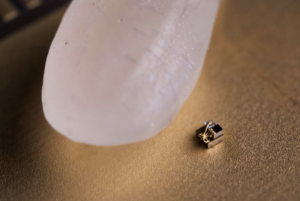
World’s smallest computer smaller than a grain of rice

IBM revealed in March 2018, “world’s smallest Computer”, but a team at University of Michigan has brought out even smaller computer that’s “dwarfed by a grain of rice”, measuring just 0.33mm on each side. The University originally held the “world’s smallest” trophy with its 2mm x 2mm x 4mm Michigan Micro until IBM’s smaller-than-salt 1mm x 1mm computer.
When you power off a desktop or laptop, all the programs and data still reside on the device’s internal storage. Boot up the device and all you files, videos, photos and documents reappear.
The smallest computer created by IBM and Michigan team would not do that.
The Michigan Team’s new “computer” uses photovoltaics, a method of converting light into electricity, and also has a processor, system memory and wireless transmitters and receivers that send and receive data through light. Currently the computer serves as a high precision temperature sensor and uses electronic pulses to convert temperatures into timed intervals and has ability to report temperatures in a cluster of cells within a tumour with an error rate of around 0.1 degrees Celsius.
Gary Luker, professor of radiology and biomedical engineering said: “ Since the temperature sensor is small and biocompatible, we can implant it into a mouse and cancer cells grow around it. We are using this temperature sensor to investigate variations in temperature within a tumour versus normal tissue and if we can use changes in temperature to determine success or failure of therapy.”
The tiniest computer is flexible enough to be attuned for a variety of needs such as audio and video surveillance, oil reservoir monitoring, cancer studies.
Part of Michigan team is David Blaauw, a professor of electrical and computer engineering and Professor of ECE Dennis Sylvester and Jamie Phillips, Arthur F Thurnau professor.
“We had to basically invent new ways of approaching circuit design that would be equally low power but could also tolerate light” Blaauw said.
